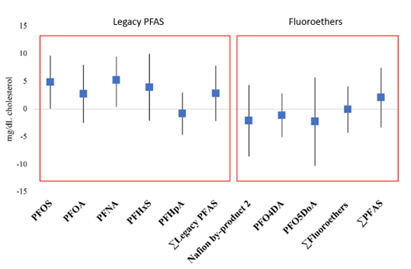Superfund Research Program
PFAS Exposure Associated with Elevated Cholesterol in North Carolina Community
View Research Brief as PDF(349KB)
Release Date: 11/02/2022
![]() subscribe/listen via iTunes, download(6.0MB), Transcript(89KB)
subscribe/listen via iTunes, download(6.0MB), Transcript(89KB)
NIEHS Superfund Research Program (SRP)-funded researchers found that elevated levels of per- and polyfluoroalkyl substances (PFAS) in the blood of participants of the GenX Exposure Study were associated with higher cholesterol. Led by Jane Hoppin, ScD., of the North Carolina State University SRP Center, the study started in 2017 in response to the concerns of residents of Wilmington, North Carolina, about PFAS in their drinking water.
The Cape Fear River Basin, which provides drinking water for Wilmington residents, is downstream of a fluorochemical plant. The plant manufactures building blocks for fluoropolymers and previously discharged high concentrations of PFAS, including GenX, to the river.
GenX falls within a group of PFAS called fluoroethers, which were created to replace legacy PFAS like perfluorooctanoic acid (PFOA) and perfluorooctanesulfonate (PFOS). An extensive body of research has linked legacy PFAS to increased cholesterol, but little is known about the potential effects of fluoroethers on health.
What's in People's Blood?
The researchers analyzed blood samples from 326 Wilmington residents, obtained between 2017 and 2018, and detected a total of eight PFAS in their study population, three of which were fluoroethethers.
PFOS, PFOA, and the fluoroether Nafion byproduct 2 were detected in more than 99% of participants. They also found that the levels of PFOA, perfluorononanoic acid (PFNA), and perfluorohexane sulfonate (PFHxS) ' all legacy PFAS ' were significantly higher than levels of the general U.S. population.
GenX, the chemical that started the study, was not detected in participants' blood. However, GenX only lasts in blood for a very short time ' its half-life is about three days.
Untangling the Relationship Between PFAS and Cholesterol
The human body needs cholesterol to build healthy cells, but high levels of total cholesterol, and of non-HDL cholesterol, deposit fat in blood vessels and increase a person's risk of developing heart disease.
HDL cholesterol is known as 'good' cholesterol because it helps lower other form of cholesterol in the bloodstream. However, high levels may also increase the risk of developing heart disease.
The team analyzed the blood samples for total cholesterol and high-density lipoprotein (HDL) cholesterol and then used those measures to calculate non-HDL cholesterol.
Then, they conducted statistical analysis to estimate the associations with individual PFAS, as well as the summed concentrations of all PFAS detected.
Results showed that high levels of legacy PFAS in blood were associated with high levels of both non-HDL and total cholesterol. This association was strongest for PFOS and PFNA. Nafion byproduct 2 and 3,5,7,9,11-pentaoxadodecanoic acid (PFO5DoA) were associated with increased HDL, but these and other fluoroethers were not associated with any other outcome. According to the authors, this is the first study to examine the association between fluoroether exposure and adverse health effects.
They also looked at whether the relationship between chemicals and cholesterol differed by age and found that the association was more pronounced in people aged 63 years and older. According to the authors, this might be due to higher cumulative exposure among this group or to changes in underlying susceptibility. For participants aged 18 years and younger, there were no associations between chemical exposure and cholesterol.
A More Complete Picture

The authors noted that evaluating the health impacts of individual PFAS is challenging since people are exposed to multiple PFAS ' from different sources and with different half-lives ' simultaneously. For example, fluoroethers with short half-lives may not be detected in people's blood but that doesn't mean that past exposures are risk-free, Hoppin explained in a recent webinar.
According to Hoppin, to understand long term health effects from fluoroether exposures, future research needs to estimate exposure using information on water levels and consumption. Future studies should also include a larger sample size to be able to better control for multiple exposures, the authors said. They also emphasized that including fluoroethers in research studies is critical, given their increasing use and structural similarity to legacy PFAS.
For More Information Contact:
Jane A. Hoppin
North Carolina State University
Department of Biological Sciences
Campus Box 7633
Raleigh, North Carolina 27695-7633
Phone: 919-515-2918
Email: jahoppin@ncsu.edu
To learn more about this research, please refer to the following sources:
- Rosen EM, Kotlarz N, Knappe D, Lea CS, Collier D, Richardson DB, Hoppin JA. 2022. Drinking water-associated PFAS and fluroethers and lipid outcomes in the GenX exposure study. Environ Health Perspect 130(9):97002. doi:10.1289/EHP11033 PMID:36069575 PMCID:PMC9450637
To receive monthly mailings of the Research Briefs, send your email address to srpinfo@niehs.nih.gov.


